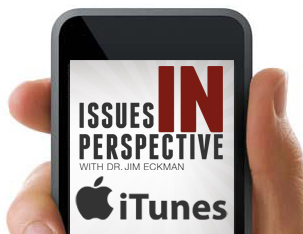The UK’s Supreme Court Decision On Trans Women
May 31st, 2025 | By Dr. Jim Eckman | Category: Featured Issues, Politics & Current EventsThe mission of Issues in Perspective is to provide thoughtful, historical and biblically-centered perspectives on current ethical and cultural issues.

In mid-April, the United Kingdom’s Supreme Court unanimously ruled that trans women do not fall within the legal definition of women under the country’s equality legislation. This landmark 88-page ruling that the legal definition of a woman is based on biological sex, is a blow to campaigners for transgender rights. As Lizzie Dearden of the New York Times reported, “[T]he five judges involved in the ruling emphasized that they were not commenting more broadly on whether trans women are women, saying it was not the role of the court to adjudicate on the meaning of gender or sex. Instead, the judgment is limited to the precise interpretation of language in the 2010 Equality Act, which aims to prevent discrimination.”
What exactly did the UK court say? The deputy president of the court, Lord Patrick Hodge, declared: “The unanimous decision of this court is that the terms ‘woman’ and ‘sex’ in the Equality Act 2010 refer to biological women and biological sex.” He added: “We counsel against reading this judgment as a triumph of one or more groups in our society at the expense of another. It is not.” He said that trans people would continue to have protections against discrimination, but that it would be under the protected characteristic of “gender reassignment” rather than sex. “It is not the task of this court to make policy on how the interests of these groups should be protected,” he added, but “to ascertain the meaning of the legislation which Parliament has enacted.” Although the case was focused on the legal definition of women, it also applies to trans men because the Supreme Court ruled on the broader meaning of “sex” as being “biological sex” under the Equality Act.
How might this affect trans people in the UK? Dearden observes correctly that “Legal experts said it would take time to digest the implications of the court’s 88-page ruling. But one likely effect is that it will be easier for single-sex facilities to exclude trans people. Under Britain’s Equality Act, it was already legal for some services or facilities to be provided for one sex only, under certain circumstances. For instance, rape crisis centers, changing rooms and female-only hospital wards could be restricted to one sex, the law said, if ‘a person of one sex might reasonably object to the presence of a person of the opposite sex.’ However, many legal experts had argued that the contradictions between the Equality Act and the Gender Recognition Act of 2004—which states that a trans person with a certificate is legally of their acquired gender—meant that people running single-sex facilities struggled to know if they were on the right side of the law if they excluded trans people. The court’s decision aims to clarify that.”
What has been the effect of this decision? Susan Smith, the co-director of For Women Scotland, the activist group that had brought the legal challenge, said the judgment would ensure that “services and spaces designated for women are for women.” She added: “Everybody should be protected by the Equality Act. This is not about prejudice or bigotry, as some people would say, it’s not about hatred for another community. It’s just about saying that there are differences, and biology is one of those differences, and we just need protections based on that.” J.K. Rowling, the creator of the Harry Potter series, supported For Women Scotland in their legal campaign. She said she was “proud” of the group in a post on X, and claimed the case had “protected the rights of women and girls across the U.K.” However Simon Blake, the CEO of Stonewall UK, an LGBTQ+ charity, said that the ruling “will be incredibly worrying for the trans community and all of us who support them.”
Why did the UK Supreme Court get involved? Dearden take us back to 2018: “The origins of the ruling lie in a law passed by the Scottish Parliament in 2018, aiming to increase the proportion of women on government agency boards to 50 percent. As part of that legislation, the government said that trans women could count toward the target. For Women Scotland took the Scottish government to court, arguing that trans women should not be included in the quotas. The government amended its guidance to say that only trans women with a so-called gender recognition certificate met the definition of a woman under the Equality Act of 2010, and could therefore be included in the quotas. Gender recognition certificates are legal documents that can be granted by the British government to people who have lived in their acquired gender for two years and intend to do so for the rest of their life, and who have been diagnosed with gender dysphoria. The process, which has not been changed by [the UK Court] ruling, grants successful applicants the right to update their sex on official documents such as birth certificates, and to marry in their affirmed gender.”
In short, the Court affirmed that the category of woman “does not include male persons,” who may not even be taking female hormones but simply have acquired a gender recognition certificate by filling out the forms to acquire such a certificate. This was necessary because as The Week clarifies, “British men could fake being trans to invade women’s gyms and support groups. At one point, a rapist was briefly sent to a women’s prison merely because he waved a gender recognition certificate—even though it was obvious that he was pretending to be trans. That is why we needed clarity from the courts, argued Suzanne Moore.”
Because the transgender issue focuses on real people who have real struggles, this is a sensitive and very personal issue. However, as I have done before on Issues, I believe we must seek God’s perspective on this complicated issue. What follows accurately summarizes what the Bible teaches:
- Maleness and femaleness are God’s choice, determined at conception. But growing into one’s masculinity or femininity and embracing it can be thwarted by cultural and family developments. It seems reasonable to conclude that gender identity is a developmental issue.
- It is certainly true that God desires that every male grow to masculinity and every female to femininity. When that does not occur, the culture has developed labels such as transgendered and transsexual. Regardless of the labels, God sees each individual as of worth and value because they bear His image, but as broken individuals. As with every human being, the salvation offered in Jesus Christ heals the brokenness.
- As with every individual human being, our fundamental identity is in Jesus Christ. Much of the postmodern world has focused on sex or gender as the primary aspect of personal identity. But the Bible calls on us to identity with Jesus—He is our core identity, regardless of whether we are male, female, transgender, etc. Identity in Christ is a profound, transformative concept that results from placing our faith in Christ.
- It is certainly true that God intends for males to manifest masculine characteristics and females to manifest female characteristics. The fact that some people are born with evidence of mutations in sex-determining genes does not impact their value and worth to God. But the Bible is clear that men are to appear as men and women as women (e.g., Deuteronomy 22:5).
- Focus on the Family has published a helpful position paper of the transgender movement. I quote several points from that paper:
- We must remember that those who struggle with their gender identity have lived lives of great pain, confusion and rejection . . . We must humbly share [God’s] love embodied in the Gospel, to lift them up in prayer and to allow the Holy Spirit to bring about conviction, healing and transformation.
- We affirm the Christian view that to be human is to be holistically united as body and spirit. Often, transgender advocates hold to the pagan view that the body is a container that the spirit is poured into. As such, they erroneously conclude that God has mistakenly put an opposite-gendered spirit into the wrong body or that the body is not the real person—that only the spirit is real.
- We call upon parents to take a positive role in their children’s development by providing them with a strong, Christian example of what it means to be male and female.
- We believe we are called to proclaim the truth and beauty of God’s design and the redemption from sexual brokenness in our lives and culture can only come through Jesus Christ. Like everyone else, “transgendered” individuals are desperately in need of God’s truth and deserve to know the love and compassion of Christ as shown through His people.
May God, in His grace, empower the church to see transgendered people as they are to see every human being: A broken sinner desperately in need of the salvation that Jesus offers. As with all human beings, only in Christ is there healing, wholeness and the promise of a resurrected body after which the struggle with brokenness and sin will end. In eternity there will be no struggle with identity or life’s meaning. Both are fulfilled in Christ.
See Lizzie Dearden in the New York Times (17 April 2025); Gareth Vipers in the Wall Street Journal (17 April 2025); The Week (2 May 2025), p. 15; Focus on the Family Position Paper on Transgenderism at www.focusonthefamily.com; and “What is a Biblical View of Transgendered People” at www.probe.org.


